Abstract
1. Experiments were carried out to clarify the mechanisms responsible for variations in the positive inotropic effect (PIE) of angiotensin II (AII) on ventricular muscles from various mammals. We examined the density of AII receptors, the relative proportions of receptor subtypes and the acceleration of the hydrolysis of phosphoinositide that was induced by AII, as well as the PIE of AII in ventricular muscles from the rabbit, dog, rat and ferret. 2. In the rabbit, AII (1 microM) in the presence of bupranolol (0.3 microM) and prazosin (0.1 microM) elicited a concentration-dependent PIE, which was antagonized by a selective AT1 subtype antagonist, losartan, but not by an AT2 antagonist, PD123319. AII did not have any inotropic effects in ventricular muscles from the dog, rat and ferret. 3. Specific high-affinity binding of [125I]-AII, with a similar Kd value in each case (1-2 nM), was observed with membrane fractions derived from ventricular muscle of all four species tested. 4. In the rabbit, losartan and PD123319 each displaced approximately 50% of [125I]-AII specific binding having high affinity for the receptors, and indicating that AT1 and AT2 subtypes were present in equal numbers. In the other species the AT1 subtype of receptors was predominant. 5. In all four species AII caused a concentration-dependent acceleration of the hydrolysis of phosphoinositide in ventricular slices that had been prelabelled with myo-[3H]-inositol. 6. The results indicate that the signal-transduction process distal to acceleration of the hydrolysis of phosphoinositide may be responsible for the wide range of species variations in the inotropic action of AII on mammalian ventricular myocardium.
Full text
PDF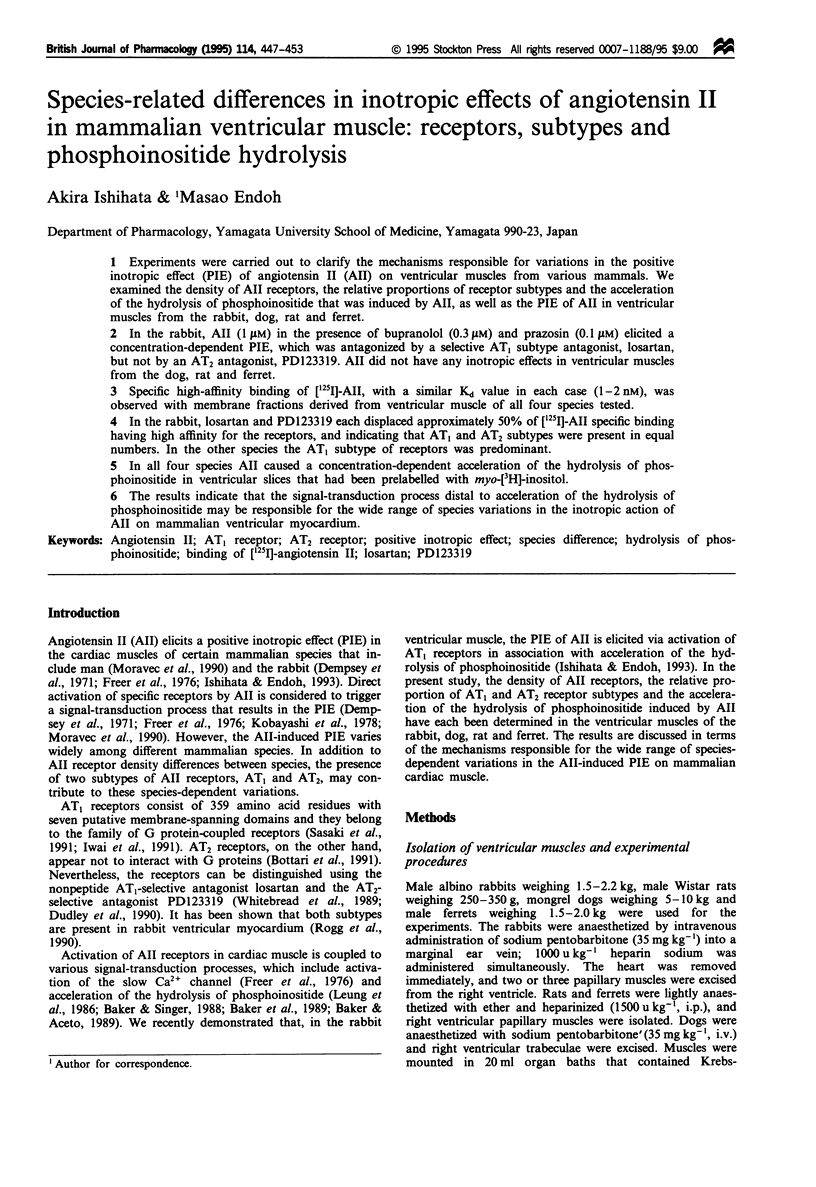
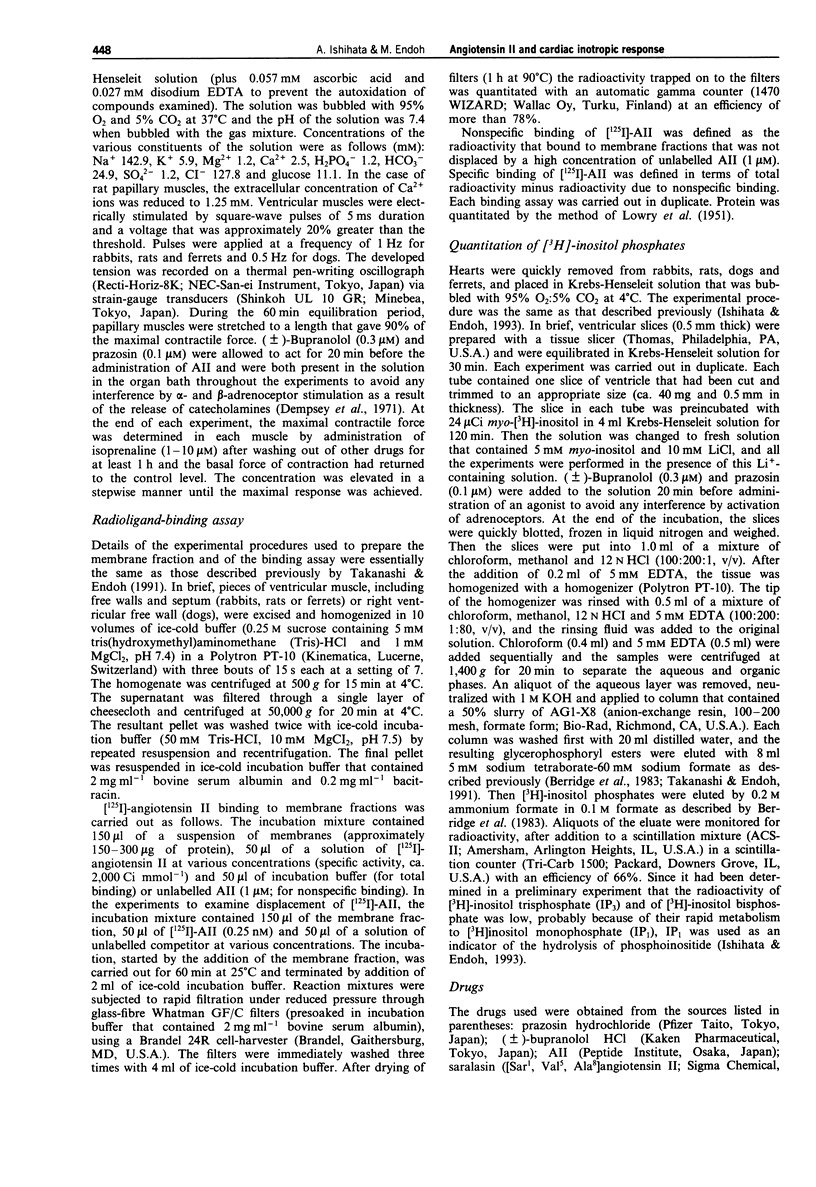
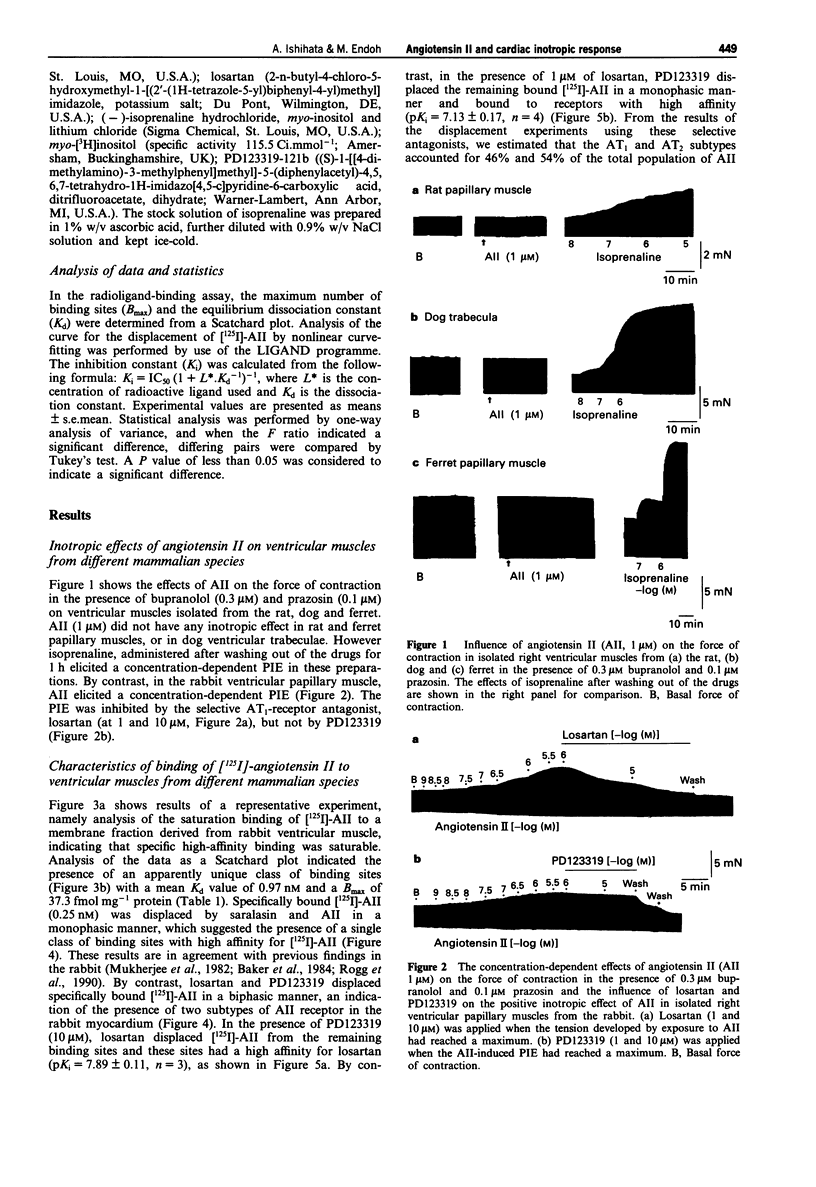
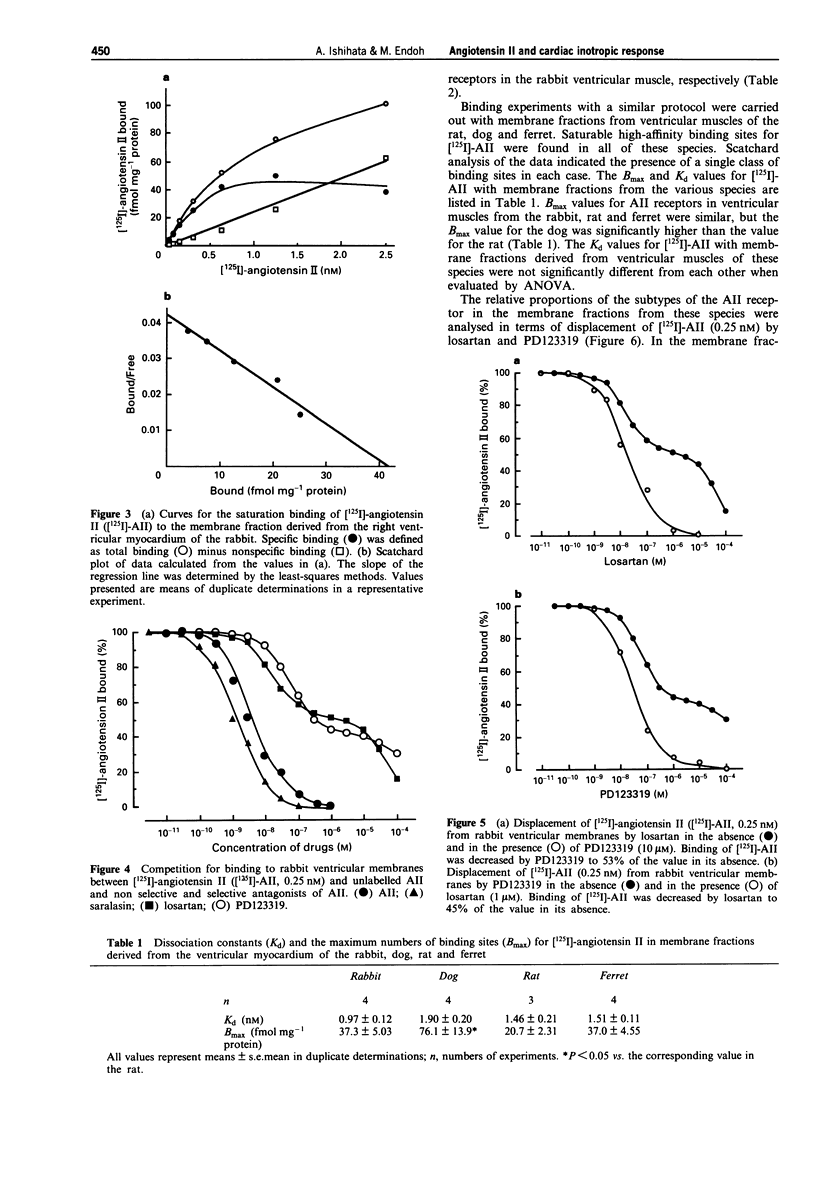
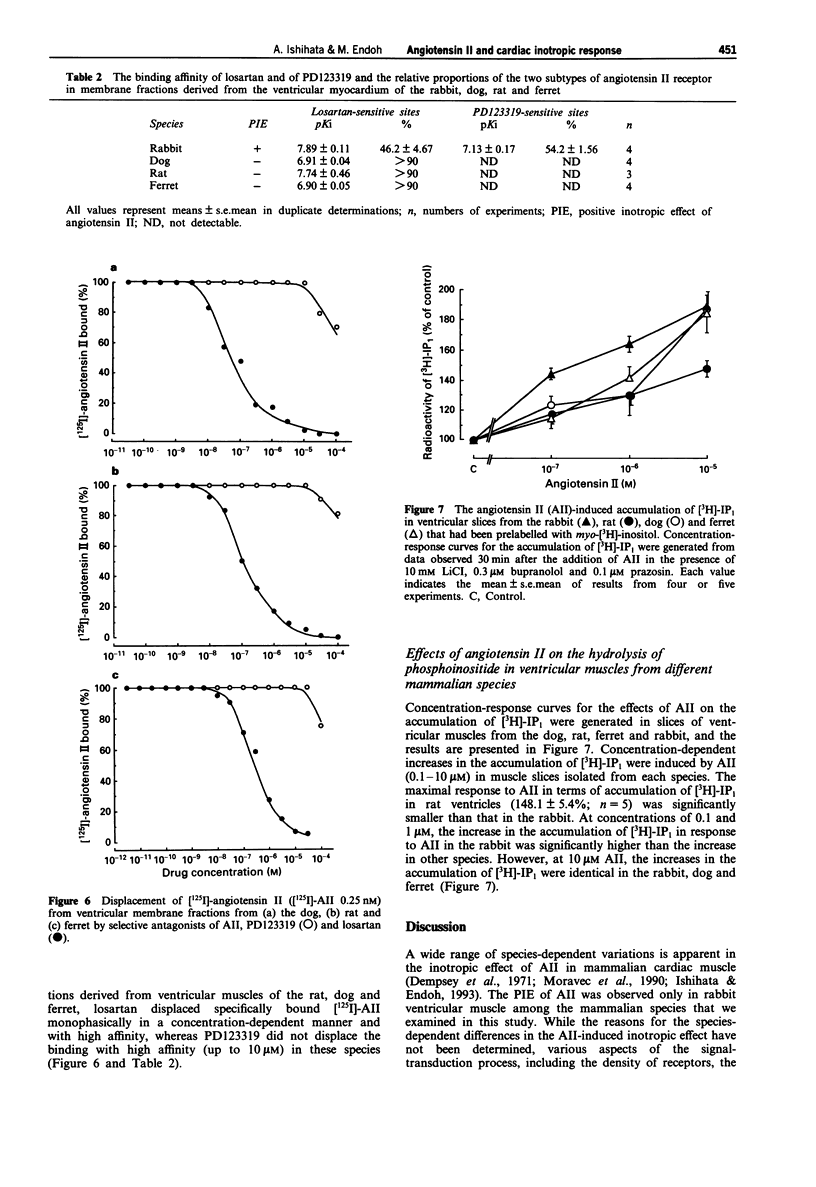
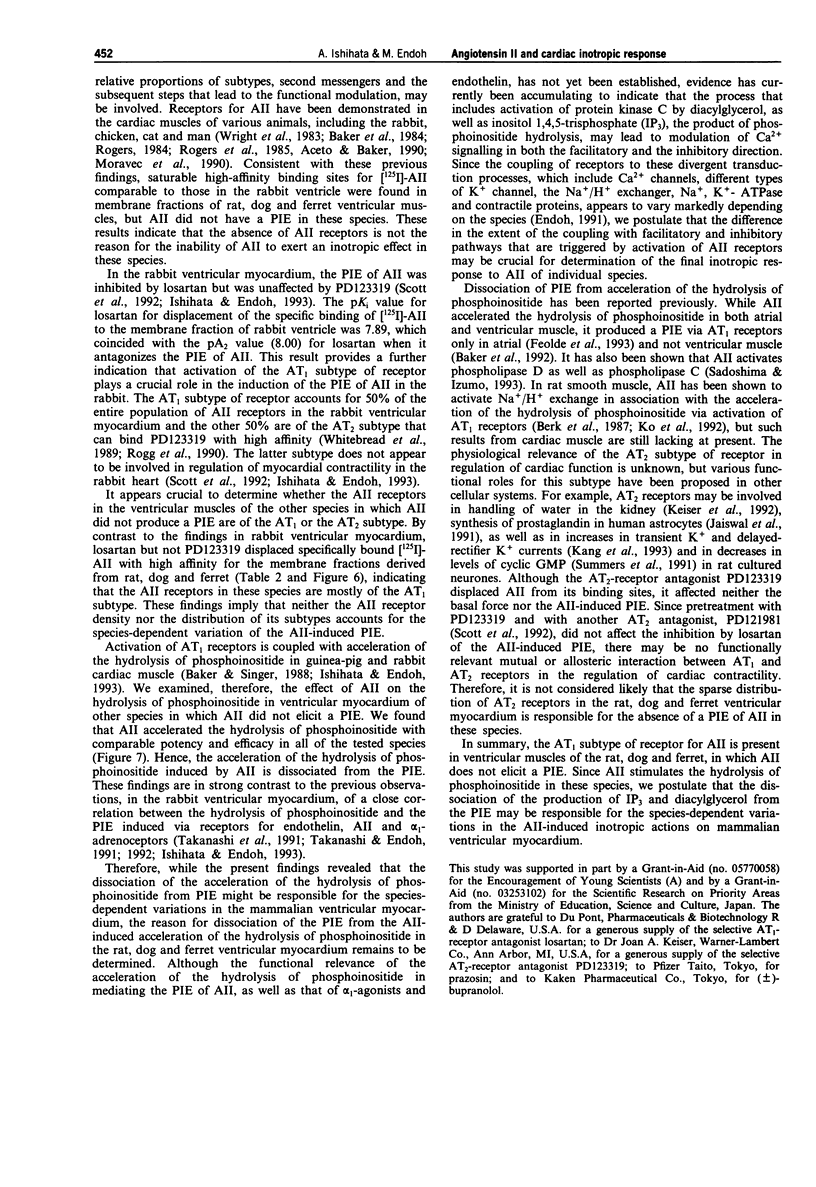
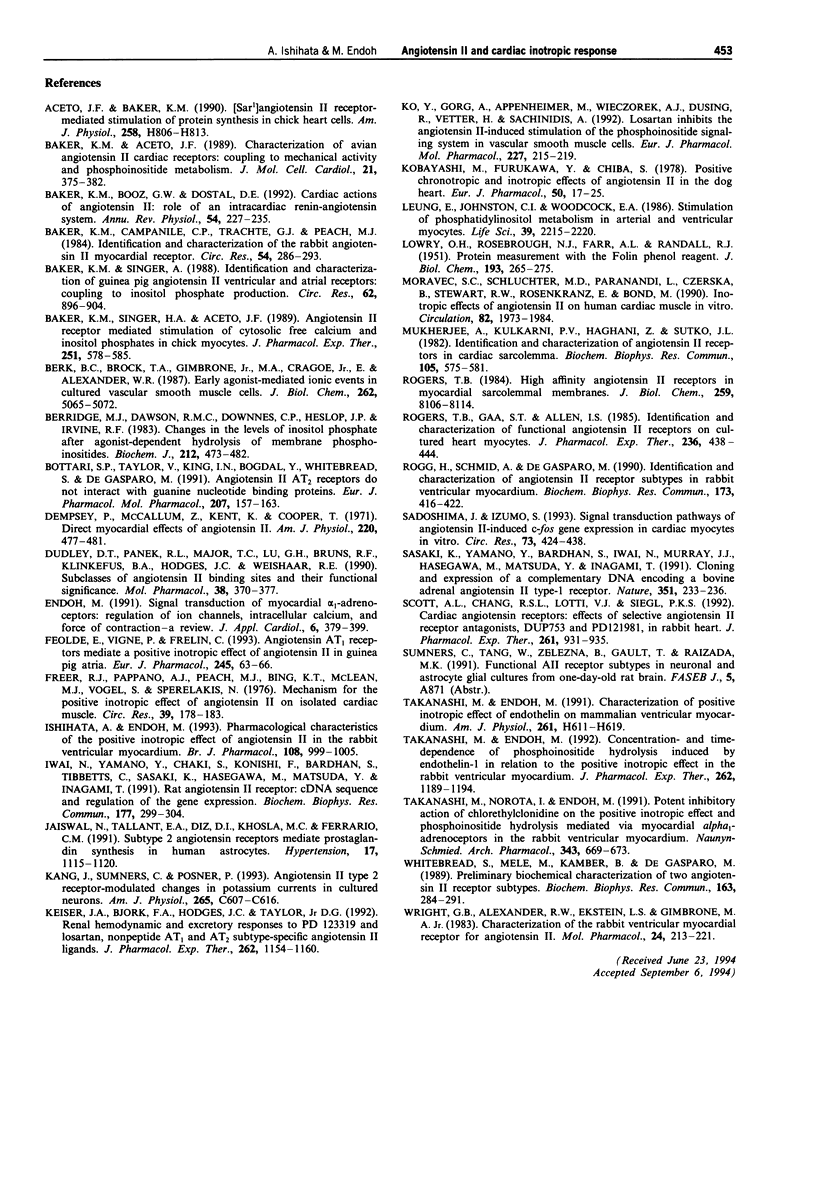
Selected References
These references are in PubMed. This may not be the complete list of references from this article.
- Aceto J. F., Baker K. M. [Sar1]angiotensin II receptor-mediated stimulation of protein synthesis in chick heart cells. Am J Physiol. 1990 Mar;258(3 Pt 2):H806–H813. doi: 10.1152/ajpheart.1990.258.3.H806. [DOI] [PubMed] [Google Scholar]
- Baker K. M., Aceto J. A. Characterization of avian angiotensin II cardiac receptors: coupling to mechanical activity and phosphoinositide metabolism. J Mol Cell Cardiol. 1989 Apr;21(4):375–382. doi: 10.1016/0022-2828(89)90648-2. [DOI] [PubMed] [Google Scholar]
- Baker K. M., Booz G. W., Dostal D. E. Cardiac actions of angiotensin II: Role of an intracardiac renin-angiotensin system. Annu Rev Physiol. 1992;54:227–241. doi: 10.1146/annurev.ph.54.030192.001303. [DOI] [PubMed] [Google Scholar]
- Baker K. M., Campanile C. P., Trachte G. J., Peach M. J. Identification and characterization of the rabbit angiotensin II myocardial receptor. Circ Res. 1984 Mar;54(3):286–293. doi: 10.1161/01.res.54.3.286. [DOI] [PubMed] [Google Scholar]
- Baker K. M., Singer H. A., Aceto J. F. Angiotensin II receptor-mediated stimulation of cytosolic-free calcium and inositol phosphates in chick myocytes. J Pharmacol Exp Ther. 1989 Nov;251(2):578–585. [PubMed] [Google Scholar]
- Baker K. M., Singer H. A. Identification and characterization of guinea pig angiotensin II ventricular and atrial receptors: coupling to inositol phosphate production. Circ Res. 1988 May;62(5):896–904. doi: 10.1161/01.res.62.5.896. [DOI] [PubMed] [Google Scholar]
- Berk B. C., Brock T. A., Gimbrone M. A., Jr, Alexander R. W. Early agonist-mediated ionic events in cultured vascular smooth muscle cells. Calcium mobilization is associated with intracellular acidification. J Biol Chem. 1987 Apr 15;262(11):5065–5072. [PubMed] [Google Scholar]
- Berridge M. J., Dawson R. M., Downes C. P., Heslop J. P., Irvine R. F. Changes in the levels of inositol phosphates after agonist-dependent hydrolysis of membrane phosphoinositides. Biochem J. 1983 May 15;212(2):473–482. doi: 10.1042/bj2120473. [DOI] [PMC free article] [PubMed] [Google Scholar]
- Bottari S. P., Taylor V., King I. N., Bogdal Y., Whitebread S., de Gasparo M. Angiotensin II AT2 receptors do not interact with guanine nucleotide binding proteins. Eur J Pharmacol. 1991 Jun 19;207(2):157–163. doi: 10.1016/0922-4106(91)90091-u. [DOI] [PubMed] [Google Scholar]
- Dempsey P. J., McCallum Z. T., Kent K. M., Cooper T. Direct myocardial effects of angiotensin II. Am J Physiol. 1971 Feb;220(2):477–481. doi: 10.1152/ajplegacy.1971.220.2.477. [DOI] [PubMed] [Google Scholar]
- Dudley D. T., Panek R. L., Major T. C., Lu G. H., Bruns R. F., Klinkefus B. A., Hodges J. C., Weishaar R. E. Subclasses of angiotensin II binding sites and their functional significance. Mol Pharmacol. 1990 Sep;38(3):370–377. [PubMed] [Google Scholar]
- Feolde E., Vigne P., Frelin C. Angiotensin AT1 receptors mediate a positive inotropic effect of angiotensin II in guinea pig atria. Eur J Pharmacol. 1993 Mar 15;245(1):63–66. doi: 10.1016/0922-4106(93)90170-e. [DOI] [PubMed] [Google Scholar]
- Freer R. J., Pappano A. J., Peach M. J., Bing K. T., McLean M. J., Vogel S., Sperelakis N. Mechanism for the postive inotropic effect of angiotensin II on isolated cardiac muscle. Circ Res. 1976 Aug;39(2):178–183. doi: 10.1161/01.res.39.2.178. [DOI] [PubMed] [Google Scholar]
- Ishihata A., Endoh M. Pharmacological characteristics of the positive inotropic effect of angiotensin II in the rabbit ventricular myocardium. Br J Pharmacol. 1993 Apr;108(4):999–1005. doi: 10.1111/j.1476-5381.1993.tb13497.x. [DOI] [PMC free article] [PubMed] [Google Scholar]
- Iwai N., Yamano Y., Chaki S., Konishi F., Bardhan S., Tibbetts C., Sasaki K., Hasegawa M., Matsuda Y., Inagami T. Rat angiotensin II receptor: cDNA sequence and regulation of the gene expression. Biochem Biophys Res Commun. 1991 May 31;177(1):299–304. doi: 10.1016/0006-291x(91)91982-i. [DOI] [PubMed] [Google Scholar]
- Jaiswal N., Tallant E. A., Diz D. I., Khosla M. C., Ferrario C. M. Subtype 2 angiotensin receptors mediate prostaglandin synthesis in human astrocytes. Hypertension. 1991 Jun;17(6 Pt 2):1115–1120. doi: 10.1161/01.hyp.17.6.1115. [DOI] [PubMed] [Google Scholar]
- Kang J., Sumners C., Posner P. Angiotensin II type 2 receptor-modulated changes in potassium currents in cultured neurons. Am J Physiol. 1993 Sep;265(3 Pt 1):C607–C616. doi: 10.1152/ajpcell.1993.265.3.C607. [DOI] [PubMed] [Google Scholar]
- Keiser J. A., Bjork F. A., Hodges J. C., Taylor D. G., Jr Renal hemodynamic and excretory responses to PD 123319 and losartan, nonpeptide AT1 and AT2 subtype-specific angiotensin II ligands. J Pharmacol Exp Ther. 1992 Sep;262(3):1154–1160. [PubMed] [Google Scholar]
- Ko Y., Görg A., Appenheimer M., Wieczorek A. J., Düsing R., Vetter H., Sachinidis A. Losartan inhibits the angiotensin II-induced stimulation of the phosphoinositide signalling system in vascular smooth muscle cells. Eur J Pharmacol. 1992 Oct 1;227(2):215–219. doi: 10.1016/0922-4106(92)90130-n. [DOI] [PubMed] [Google Scholar]
- Kobayashi M., Furukawa Y., Chiba S. Positive chronotropic and inotropic effects of angiotensin II in the dog heart. Eur J Pharmacol. 1978 Jul 1;50(1):17–25. doi: 10.1016/0014-2999(78)90249-2. [DOI] [PubMed] [Google Scholar]
- LOWRY O. H., ROSEBROUGH N. J., FARR A. L., RANDALL R. J. Protein measurement with the Folin phenol reagent. J Biol Chem. 1951 Nov;193(1):265–275. [PubMed] [Google Scholar]
- Leung E., Johnston C. I., Woodcock E. A. Stimulation of phosphatidylinositol metabolism in atrial and ventricular myocytes. Life Sci. 1986 Dec 8;39(23):2215–2220. doi: 10.1016/0024-3205(86)90399-1. [DOI] [PubMed] [Google Scholar]
- Moravec C. S., Schluchter M. D., Paranandi L., Czerska B., Stewart R. W., Rosenkranz E., Bond M. Inotropic effects of angiotensin II on human cardiac muscle in vitro. Circulation. 1990 Dec;82(6):1973–1984. doi: 10.1161/01.cir.82.6.1973. [DOI] [PubMed] [Google Scholar]
- Mukherjee A., Kulkarni P. V., Haghani Z., Sutko J. L. Identification and characterization of angiotensin II receptors in cardiac sarcolemma. Biochem Biophys Res Commun. 1982 Mar 30;105(2):575–581. doi: 10.1016/0006-291x(82)91473-5. [DOI] [PubMed] [Google Scholar]
- Rogers T. B., Gaa S. T., Allen I. S. Identification and characterization of functional angiotensin II receptors on cultured heart myocytes. J Pharmacol Exp Ther. 1986 Feb;236(2):438–444. [PubMed] [Google Scholar]
- Rogers T. B. High affinity angiotensin II receptors in myocardial sarcolemmal membranes. Characterization of receptors and covalent linkage of 125I-angiotensin II to a membrane component of 116,000 daltons. J Biol Chem. 1984 Jul 10;259(13):8106–8114. [PubMed] [Google Scholar]
- Rogg H., Schmid A., de Gasparo M. Identification and characterization of angiotensin II receptor subtypes in rabbit ventricular myocardium. Biochem Biophys Res Commun. 1990 Nov 30;173(1):416–422. doi: 10.1016/s0006-291x(05)81074-5. [DOI] [PubMed] [Google Scholar]
- Sadoshima J., Izumo S. Signal transduction pathways of angiotensin II--induced c-fos gene expression in cardiac myocytes in vitro. Roles of phospholipid-derived second messengers. Circ Res. 1993 Sep;73(3):424–438. doi: 10.1161/01.res.73.3.424. [DOI] [PubMed] [Google Scholar]
- Sasaki K., Yamano Y., Bardhan S., Iwai N., Murray J. J., Hasegawa M., Matsuda Y., Inagami T. Cloning and expression of a complementary DNA encoding a bovine adrenal angiotensin II type-1 receptor. Nature. 1991 May 16;351(6323):230–233. doi: 10.1038/351230a0. [DOI] [PubMed] [Google Scholar]
- Scott A. L., Chang R. S., Lotti V. J., Siegl P. K. Cardiac angiotensin receptors: effects of selective angiotensin II receptor antagonists, DUP 753 and PD 121981, in rabbit heart. J Pharmacol Exp Ther. 1992 Jun;261(3):931–935. [PubMed] [Google Scholar]
- Takanashi M., Endoh M. Characterization of positive inotropic effect of endothelin on mammalian ventricular myocardium. Am J Physiol. 1991 Sep;261(3 Pt 2):H611–H619. doi: 10.1152/ajpheart.1991.261.3.H611. [DOI] [PubMed] [Google Scholar]
- Takanashi M., Endoh M. Concentration- and time-dependence of phosphoinositide hydrolysis induced by endothelin-1 in relation to the positive inotropic effect in the rabbit ventricular myocardium. J Pharmacol Exp Ther. 1992 Sep;262(3):1189–1194. [PubMed] [Google Scholar]
- Takanashi M., Norota I., Endoh M. Potent inhibitory action of chlorethylclonidine on the positive inotropic effect and phosphoinositide hydrolysis mediated via myocardial alpha 1-adrenoceptors in the rabbit ventricular myocardium. Naunyn Schmiedebergs Arch Pharmacol. 1991 Jun;343(6):669–673. doi: 10.1007/BF00184301. [DOI] [PubMed] [Google Scholar]
- Whitebread S., Mele M., Kamber B., de Gasparo M. Preliminary biochemical characterization of two angiotensin II receptor subtypes. Biochem Biophys Res Commun. 1989 Aug 30;163(1):284–291. doi: 10.1016/0006-291x(89)92133-5. [DOI] [PubMed] [Google Scholar]
- Wright G. B., Alexander R. W., Ekstein L. S., Gimbrone M. A., Jr Characterization of the rabbit ventricular myocardial receptor for angiotensin II. Evidence for two sites of different affinities and specificities. Mol Pharmacol. 1983 Sep;24(2):213–221. [PubMed] [Google Scholar]


